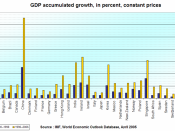The foundation for a gradual recovery in Japan's economy is being laid as the environment for exports and business sentiment have improved. This development occurs against the background of a cyclical rebound in global demand for IT-related goods as well as the progress of structural adjustment, including the improvement of corporate profitability.
Structural adjustment of Japan's economy is but halfway complete, and many issues remain to be resolved. Persistent adjustment pressures have weighed heavily on the self-sustaining recovery of domestic demand, which needs to be duly taken into account in the conduct of monetary policy.
Under such circumstances, the Bank of Japan will continue to firmly maintain its quantitative easing policy until the consumer price index registers stably zero percent or an increase year on year. We think it important to ensure that the current nascent economic recovery is put on a sustainable path. In this regard, on October 10, the Bank decided to take such measures as raising the upper limit of the target balance of current accounts in the interest of more flexible and timely monetary operations.
We need to put the issues facing Japan's economy, including structural adjustment, into a historical perspective that encompasses such issues as globalization and the maturity of Japan's society and economy. Hence, today I would like to look back upon the process of structural adjustment in the Japanese economy, and address current problems with a focus on three key concepts, "value added," "risk" and "sustainability."
I. The Path to Date of the Japanese Economy
A. High Economic Growth
I should start by reviewing the high economic growth period between 1955 and 1970. During this 15-year period, real GDP almost quadrupled with an annual growth rate of nearly 10 percent. Such high growth was only possible because of the potential endowed to...


